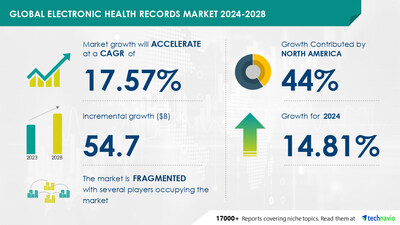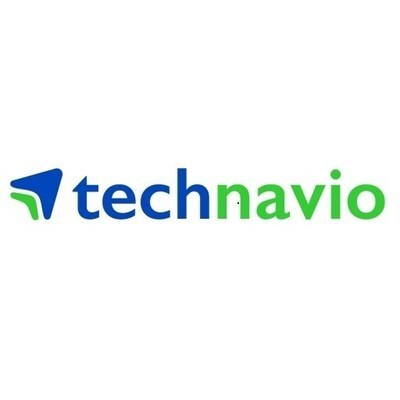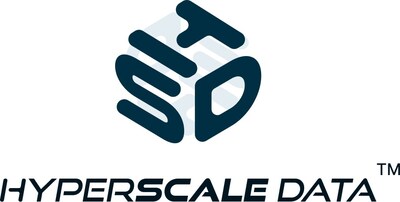Electronic Health Records Market size is set to grow by USD 54.7 billion from 2024-2028, Benefits of EHR leading to rise in adoption boost the market, AI Role and Impact, Technavio
Press Releases
Aug 22, 2024
NEW YORK, Aug. 22, 2024 /PRNewswire/ — The global electronic health records market size is estimated to grow by USD 54.7 billion from 2024-2028, according to Technavio. The market is estimated to grow at a CAGR of over 17.57% during the forecast period. Benefits of ehr leading to rise in adoption is driving market growth, with a trend towards rising demand for self-medication and homecare medical devices. However, rising data security and privacy concerns poses a challenge. Key market players include athenahealth Inc., CareCloud Inc., Computer Programs and Systems Inc., CureMD, Dedalus Group, Dell Technologies Inc., eClinicalWorks LLC, Epic Systems Corp., EverCommerce Inc., General Electric Co., Global Payments Inc., Greenway Health LLC, KareXpert Technologies Pvt. Ltd., McKesson Corp., MEDHOST, Medical Information Technology Inc., Oracle Corp., Siemens AG, Tebra Technologies Inc., and Veradigm LLC.
Get a detailed analysis on regions, market segments, customer landscape, and companies- View the snapshot of this report
|
Electronic Health Records Market Scope |
|
|
Report Coverage |
Details |
|
Base year |
2023 |
|
Historic period |
2018 – 2022 |
|
Forecast period |
2024-2028 |
|
Growth momentum & CAGR |
Accelerate at a CAGR of 17.57% |
|
Market growth 2024-2028 |
USD 54.7 billion |
|
Market structure |
Fragmented |
|
YoY growth 2022-2023 (%) |
14.81 |
|
Regional analysis |
North America, Europe, Asia, and Rest of World (ROW) |
|
Performing market contribution |
North America at 44% |
|
Key countries |
US, Canada, UK, Germany, and China |
|
Key companies profiled |
athenahealth Inc., CareCloud Inc., Computer Programs and Systems Inc., CureMD, Dedalus Group, Dell Technologies Inc., eClinicalWorks LLC, Epic Systems Corp., EverCommerce Inc., General Electric Co., Global Payments Inc., Greenway Health LLC, KareXpert Technologies Pvt. Ltd., McKesson Corp., MEDHOST, Medical Information Technology Inc., Oracle Corp., Siemens AG, Tebra Technologies Inc., and Veradigm LLC |
Market Driver
The global population aging trend, with over 50% expected to be over 65 years by 2039, is driving the healthcare industry’s shift from diagnosis and cure to prevention. Developing countries in Asia and MEA, with higher population growth, are following suit. Remote healthcare, wireless treatment, and minimally invasive treatments are gaining popularity. Preventive care necessitates investments in home care, remote monitoring, telehealth, and self-monitoring solutions. Self-medication and home-based treatments are on the rise, with increasing awareness of lifestyle disorders and technology adoption. Technological advancements in devices like BP machines, insulin kits, glucose monitors, nebulizers, and oxygen concentrators fuel this trend. Remote communication technologies enable efficient and effective care, making home care and self-care more convenient for consumers, while healthcare professionals benefit from easily accessible patient data. In developing countries, limited healthcare access presents an opportunity for Electronic Health Record (EHR) vendors. Challenges include pricing and distribution, but the growing use of self-care and homecare medical devices will increase the need for data collection and storage in electronic form, making EHRs essential. These factors contribute to the growth of the EHR market during the forecast period.
The Electronic Health Records (EHR) market is experiencing significant growth due to the digitalization of healthcare. Hospitals, healthcare units, rehabilitation centers, and clinics are increasingly adopting EHR systems to streamline paperwork and improve patient care. The professional services segment is a key driver of this trend, offering consulting and implementation services to advanced healthcare facilities. Chronic diseases and acute segments, including hospitals, ambulatory services, and post-acute care, are major users of EHRs. Doctors and pharmacies also benefit from these systems, accessing patient health history, medicines, allergies, immunization status, lab test results, and hospital discharge instructions. EHRs come in various forms, such as web-based, client server-based, acute, ambulatory, and post-acute. Software technology, including artificial intelligence and cloud storage, enhances EHR functionality. Big data analysis helps in disease management and population health. The geriatric population and patients with complex diseases benefit the most from these advanced systems. EHR service providers offer integrated solutions, including lab systems, radiology systems, and clinical documentation, to healthcare providers.
Explore a 360° Analysis of the Market: Unveil the Impact of AI. For complete insights- Request Sample!
Market Challenges
- The digitalization of healthcare workflows and the maintenance of electronic patient records have significantly transformed the healthcare industry. However, the increasing quantity of complex, diverse, and timely data, commonly referred to as big data, has raised concerns over the security and privacy of sensitive medical information. The growing number of cyberattacks in the healthcare sector, fueled by technologies such as clinical mobility, wireless networking, cloud computing, and information exchange, has heightened these concerns. For instance, in 2018 and 2019, American Medical Collection Agency and Dominion National experienced data breaches, potentially compromising the information of millions of patients. Unauthorized access to this data can result in serious consequences, including the obstruction of hospital databases and the unethical use of medical records. These concerns are expected to limit the growth of the global electronic health records market during the forecast period.
- The Electronic Health Records (EHR) market is growing rapidly as healthcare providers transition from paper records to digital ones. However, implementation comes with challenges. For laboratories, clinics, and advanced healthcare facilities, choosing between Web-based and client server-based EHR systems can be tough. Ambulatory care settings, including clinics, ambulatory surgical centers, and specialty centers, require solutions tailored to their needs. Patient healthcare records include vital information like health history, medicines, allergies, immunization status, lab test results, hospital discharge instructions, and billing information. Integrating lab systems, radiology systems, and pharmacy systems is crucial. Clinical documentation and administrative applications are essential for healthcare financing. EHRs must accommodate the needs of various healthcare providers, including physicians, acute care, and post-acute care. Geriatric population and diseases require special attention. Software technology, including artificial intelligence and cloud storage, can streamline processes. EHR service providers must ensure data security and interoperability. Lab test results, hospital discharge instructions, and billing information are administrative data, while health history, clinical documentation, and clinical trial data are clinical applications. Inpatient EHRs, drugs, devices, and administrative data are crucial for hospitals. On-premise software and cloud-based software offer different advantages. Overall, EHRs bring numerous benefits, but addressing these challenges is key to successful implementation.
For more insights on driver and challenges – Request a sample report!
Segment Overview
This electronic health records market report extensively covers market segmentation by
- Deployment
- 1.1 On-premises
- 1.2 Cloud-based
- Component
- 2.1 Services
- 2.2 Software
- 2.3 Hardware
- Geography
- 3.1 North America
- 3.2 Europe
- 3.3 Asia
- 3.4 Rest of World (ROW)
1.1 On-premises- On-premises Electronic Health Records (EHR) are self-hosted systems deployed on an organization’s native IT hardware and network. These systems offer physical control and improved data security as the data is managed in-house, with no third-party access. Additionally, they have a low reliance on the Internet since data is stored locally. However, small and medium-sized enterprises (SMEs) may find on-premises EHR less appealing due to the higher costs associated with the additional hardware and IT infrastructure required. Large enterprises, with sufficient resources, continue to prefer on-premises EHR for its enhanced security features and control. With growing concerns around data privacy and security, the demand for on-premises EHR is expected to rise in the global electronic health records market. Despite the benefits, on-premises EHR implementation comes with challenges such as duplicate data entry, interface issues, and customization expenses due to the need for integration with other business software.
For more information on market segmentation with geographical analysis including forecast (2024-2028) and historic data (2017-2021) – Download a Sample Report
Research Analysis
The Electronic Health Records (EHR) market is experiencing significant growth due to the digitalization of healthcare and the increasing need to manage complex patient data. The professional services segment plays a crucial role in implementing and managing EHR systems in hospitals and healthcare units. EHRs help streamline workflows, reduce paperwork, and improve patient care, particularly for those with chronic diseases. EHRs come in various forms, including Web-based and client server-based systems. Acute EHRs cater to the needs of hospitals and emergency departments, while Ambulatory EHRs are designed for outpatient care. Post-acute EHRs serve rehabilitation centers and long-term care facilities. EHRs integrate with various healthcare systems, such as lab systems, radiology systems, and pharmacy systems, to provide a comprehensive view of a patient’s healthcare records. They include clinical documentation, health history, medicines, allergies, and other vital information. Healthcare providers in advanced healthcare facilities use EHRs to access real-time patient data, improving diagnosis and treatment plans. Big data analytics derived from EHRs can also aid in population health management and research.
Market Research Overview
The Electronic Health Records (EHR) market is a dynamic and growing sector in the healthcare industry. It enables professional services segments, including hospitals, healthcare units, rehabilitation centers, and clinics, to digitize patient’s healthcare records, reducing paperwork and streamlining processes. EHR systems cater to various segments such as acute, post-acute, and ambulatory care, including Ambulatory Surgical Centers, laboratories, pharmacies, and specialty centers. These systems store essential data like health history, medicines, allergies, immunization status, lab test results, hospital discharge instructions, billing information, and administrative data. EHRs utilize advanced software technology, including artificial intelligence and cloud storage technology, to facilitate efficient data management and access. The geriatric population and those with chronic diseases significantly benefit from these systems. EHR service providers offer on-premise and cloud-based solutions to cater to diverse client needs. The market encompasses various applications, including clinical documentation, healthcare financing, and administrative applications, to enhance the overall quality of patient care.
Table of Contents:
1 Executive Summary
2 Market Landscape
3 Market Sizing
4 Historic Market Size
5 Five Forces Analysis
6 Market Segmentation
- Deployment
- On-premises
- Cloud-based
- Component
- Services
- Software
- Hardware
- Geography
- North America
- Europe
- Asia
- Rest Of World (ROW)
7 Customer Landscape
8 Geographic Landscape
9 Drivers, Challenges, and Trends
10 Company Landscape
11 Company Analysis
12 Appendix
About Technavio
Technavio is a leading global technology research and advisory company. Their research and analysis focuses on emerging market trends and provides actionable insights to help businesses identify market opportunities and develop effective strategies to optimize their market positions.
With over 500 specialized analysts, Technavio’s report library consists of more than 17,000 reports and counting, covering 800 technologies, spanning across 50 countries. Their client base consists of enterprises of all sizes, including more than 100 Fortune 500 companies. This growing client base relies on Technavio’s comprehensive coverage, extensive research, and actionable market insights to identify opportunities in existing and potential markets and assess their competitive positions within changing market scenarios.
Contacts
Technavio Research
Jesse Maida
Media & Marketing Executive
US: +1 844 364 1100
UK: +44 203 893 3200
Email: [email protected]
Website: www.technavio.com/
![]() View original content to download multimedia:https://www.prnewswire.com/news-releases/electronic-health-records-market-size-is-set-to-grow-by-usd-54-7-billion-from-2024-2028–benefits-of-ehr-leading-to-rise-in-adoption-boost-the-market-ai-role-and-impact-technavio-302228511.html
View original content to download multimedia:https://www.prnewswire.com/news-releases/electronic-health-records-market-size-is-set-to-grow-by-usd-54-7-billion-from-2024-2028–benefits-of-ehr-leading-to-rise-in-adoption-boost-the-market-ai-role-and-impact-technavio-302228511.html
SOURCE Technavio






